check oil YAMAHA JOG50R 2013 Owners Manual
[x] Cancel search | Manufacturer: YAMAHA, Model Year: 2013, Model line: JOG50R, Model: YAMAHA JOG50R 2013Pages: 76, PDF Size: 1.51 MB
Page 6 of 76
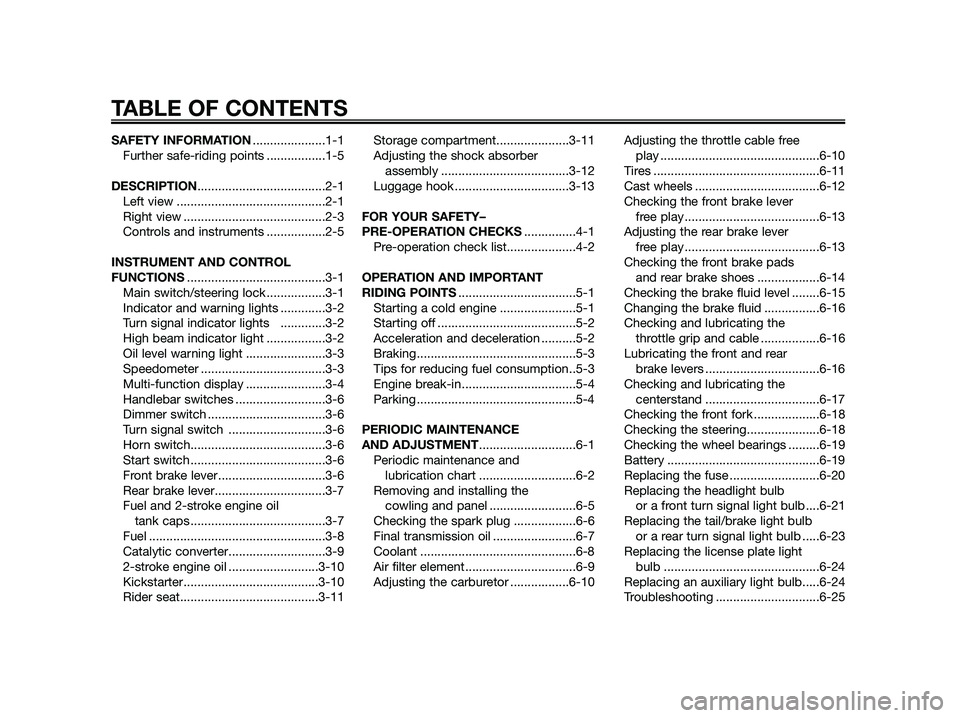
SAFETY INFORMATION.....................1-1
Further safe-riding points .................1-5
DESCRIPTION.....................................2-1
Left view ...........................................2-1
Right view .........................................2-3
Controls and instruments .................2-5
INSTRUMENT AND CONTROL
FUNCTIONS........................................3-1
Main switch/steering lock .................3-1
Indicator and warning lights .............3-2
Turn signal indicator lights .............3-2
High beam indicator light .................3-2
Oil level warning light .......................3-3
Speedometer ....................................3-3
Multi-function display .......................3-4
Handlebar switches ..........................3-6
Dimmer switch ..................................3-6
Turn signal switch ............................3-6
Horn switch.......................................3-6
Start switch .......................................3-6
Front brake lever...............................3-6
Rear brake lever................................3-7
Fuel and 2-stroke engine oil
tank caps .......................................3-7
Fuel ...................................................3-8
Catalytic converter............................3-9
2-stroke engine oil ..........................3-10
Kickstarter.......................................3-10
Rider seat........................................3-11Storage compartment.....................3-11
Adjusting the shock absorber
assembly .....................................3-12
Luggage hook .................................3-13
FOR YOUR SAFETY–
PRE-OPERATION CHECKS...............4-1
Pre-operation check list....................4-2
OPERATION AND IMPORTANT
RIDING POINTS..................................5-1
Starting a cold engine ......................5-1
Starting off ........................................5-2
Acceleration and deceleration ..........5-2
Braking..............................................5-3
Tips for reducing fuel consumption..5-3
Engine break-in.................................5-4
Parking ..............................................5-4
PERIODIC MAINTENANCE
AND ADJUSTMENT............................6-1
Periodic maintenance and
lubrication chart ............................6-2
Removing and installing the
cowling and panel .........................6-5
Checking the spark plug ..................6-6
Final transmission oil ........................6-7
Coolant .............................................6-8
Air filter element ................................6-9
Adjusting the carburetor .................6-10Adjusting the throttle cable free
play ..............................................6-10
Tires ................................................6-11
Cast wheels ....................................6-12
Checking the front brake lever
free play .......................................6-13
Adjusting the rear brake lever
free play .......................................6-13
Checking the front brake pads
and rear brake shoes ..................6-14
Checking the brake fluid level ........6-15
Changing the brake fluid ................6-16
Checking and lubricating the
throttle grip and cable .................6-16
Lubricating the front and rear
brake levers .................................6-16
Checking and lubricating the
centerstand .................................6-17
Checking the front fork ...................6-18
Checking the steering.....................6-18
Checking the wheel bearings .........6-19
Battery ............................................6-19
Replacing the fuse ..........................6-20
Replacing the headlight bulb
or a front turn signal light bulb ....6-21
Replacing the tail/brake light bulb
or a rear turn signal light bulb .....6-23
Replacing the license plate light
bulb .............................................6-24
Replacing an auxiliary light bulb.....6-24
Troubleshooting ..............................6-25
TABLE OF CONTENTS
Page 14 of 76

CS50Z
1
2
3
4
5
6 7
9
8
DESCRIPTION
2-2
2
1. Storage compartment (page 3-11)
2. Shock absorber assembly (page 3-12)
3. Final transmission oil filler cap (page 6-7)
4. Adjusting nut (page 6-13)
5. Final transmission oil drain bolt (page 6-7)6. Kickstarter (page 3-10)
7. Air filter element (page 6-9)
8. Coolant level check window (page 6-8)
9. Front brake pads (page 6-14)
Page 20 of 76
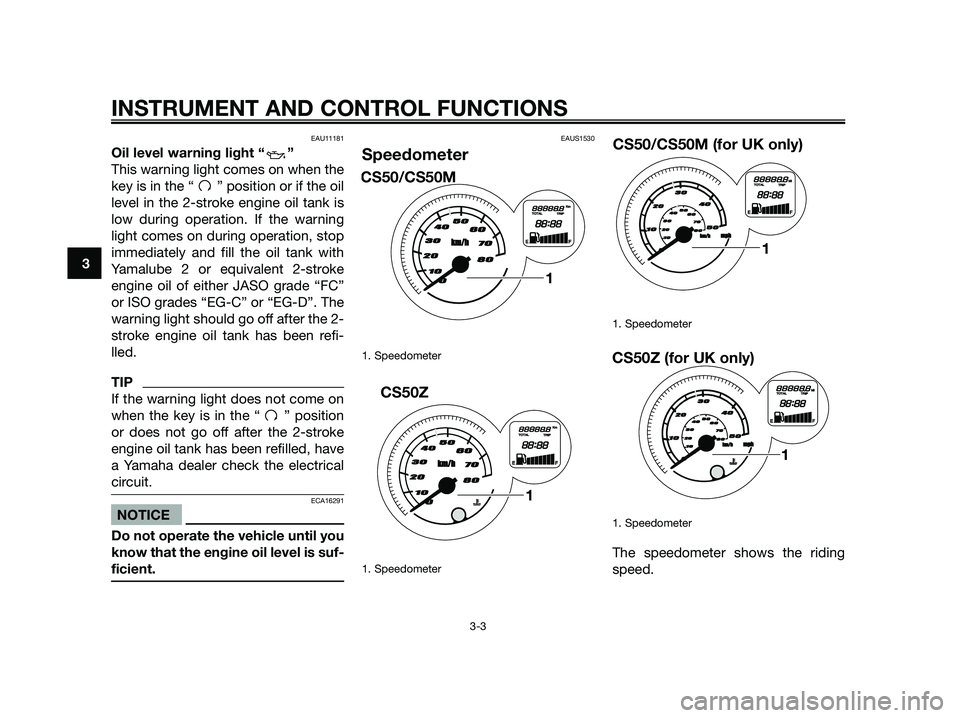
EAU11181
Oil level warning light “ ”
This warning light comes on when the
key is in the “ ” position or if the oil
level in the 2-stroke engine oil tank is
low during operation. If the warning
light comes on during operation, stop
immediately and fill the oil tank with
Yamalube 2 or equivalent 2-stroke
engine oil of either JASO grade “FC”
or ISO grades “EG-C” or “EG-D”. The
warning light should go off after the 2-
stroke engine oil tank has been refi-
lled.
TIP
If the warning light does not come on
when the key is in the “ ” position
or does not go off after the 2-stroke
engine oil tank has been refilled, have
a Yamaha dealer check the electrical
circuit.
ECA16291
NOTICE
Do not operate the vehicle until you
know that the engine oil level is suf-
ficient.
EAUS1530
Speedometer
1. Speedometer
1. Speedometer
1. Speedometer
1. Speedometer
The speedometer shows the riding
speed.
k m/hmph
0
10
203040
50
01020304050 6 0 7 0 8 0
1
CS50Z (for UK only)
k m/hmph
0
10
203040
50
01020304050 6 0 7 0 8 0
1
CS50/CS50M (for UK only)
k m/h
010
20
30405060
70
80
1
CS50Z
k m/h
010
20
30405060
70
80
1
CS50/CS50M
INSTRUMENT AND CONTROL FUNCTIONS
3-3
3
Page 32 of 76
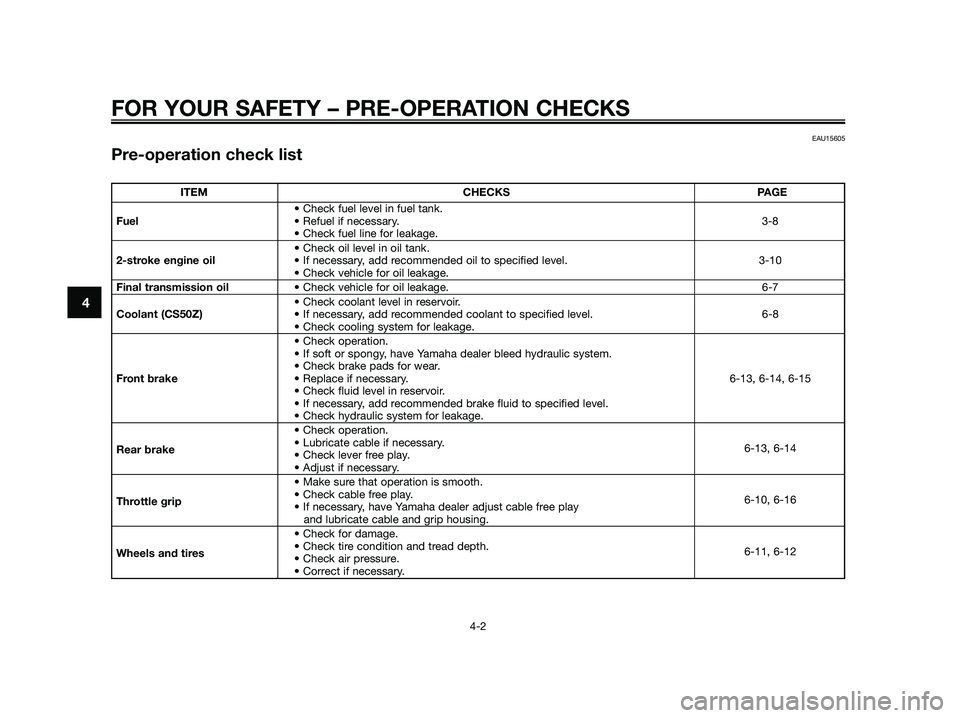
FOR YOUR SAFETY – PRE-OPERATION CHECKS
4-2
4
EAU15605
Pre-operation check list
ITEM CHECKS PAGE
• Check fuel level in fuel tank.
Fuel• Refuel if necessary.3-8
• Check fuel line for leakage.
• Check oil level in oil tank.
2-stroke engine oil• If necessary, add recommended oil to specified level. 3-10
• Check vehicle for oil leakage.
Final transmission oil• Check vehicle for oil leakage. 6-7
• Check coolant level in reservoir.
Coolant (CS50Z)• If necessary, add recommended coolant to specified level. 6-8
• Check cooling system for leakage.
• Check operation.
• If soft or spongy, have Yamaha dealer bleed hydraulic system.
• Check brake pads for wear.
Front brake• Replace if necessary. 6-13, 6-14, 6-15
• Check fluid level in reservoir.
• If necessary, add recommended brake fluid to specified level.
• Check hydraulic system for leakage.
• Check operation.
Rear brake• Lubricate cable if necessary.
• Check lever free play.6-13, 6-14
• Adjust if necessary.
• Make sure that operation is smooth.
Throttle grip• Check cable free play.
• If necessary, have Yamaha dealer adjust cable free play 6-10, 6-16
and lubricate cable and grip housing.
• Check for damage.
Wheels and tires• Check tire condition and tread depth.
• Check air pressure.6-11, 6-12
• Correct if necessary.
Page 34 of 76
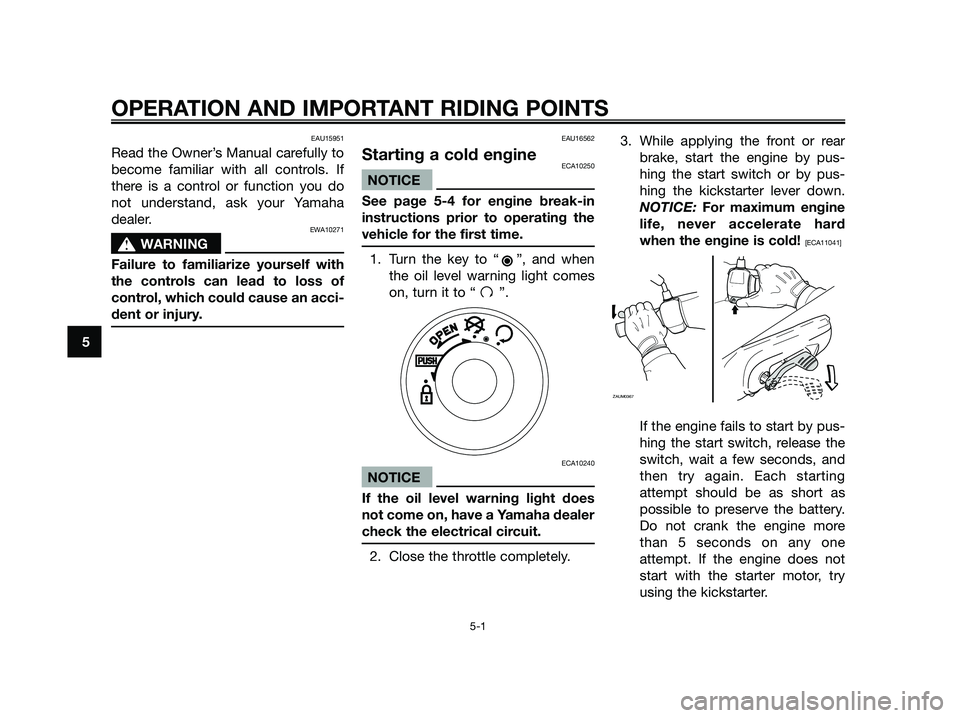
EAU15951
Read the Owner’s Manual carefully to
become familiar with all controls. If
there is a control or function you do
not understand, ask your Yamaha
dealer.
EWA10271
sWARNING
Failure to familiarize yourself with
the controls can lead to loss of
control, which could cause an acci-
dent or injury.
EAU16562
Starting a cold engineECA10250
NOTICE
See page 5-4 for engine break-in
instructions prior to operating the
vehicle for the first time.
1. Turn the key to “ ”, and when
the oil level warning light comes
on, turn it to “ ”.
ECA10240
NOTICE
If the oil level warning light does
not come on, have a Yamaha dealer
check the electrical circuit.
2. Close the throttle completely.3. While applying the front or rear
brake, start the engine by pus-
hing the start switch or by pus-
hing the kickstarter lever down.
NOTICE: For maximum engine
life, never accelerate hard
when the engine is cold!
[ECA11041]
If the engine fails to start by pus-
hing the start switch, release the
switch, wait a few seconds, and
then try again. Each starting
attempt should be as short as
possible to preserve the battery.
Do not crank the engine more
than 5 seconds on any one
attempt. If the engine does not
start with the starter motor, try
using the kickstarter.
ZAUM0367
OPERATION AND IMPORTANT RIDING POINTS
5-1
5
Page 40 of 76

PERIODIC MAINTENANCE AND ADJUSTMENT
6-3
6
ODOMETER READING
CHECK OR ANNUAL
NO. ITEM MAINTENANCE JOB
1000 km 6000 km 12000 km 18000 km 24000 kmCHECK
(600 mi) (3500 mi) (7000 mi) (10500 mi) (14000 mi)
7*Wheels• Check runout and for damage.√√√ √
• Check tread depth and for damage.
8*Tires• Replace if necessary.
√√√ √√
• Check air pressure.
• Correct if necessary.
9*Wheel bearings• Check bearing for looseness
or damage.√√√ √
• Check bearing play and steering
10 *Steering bearingsfor roughness.√√ √√ √
• Lubricate with lithium-soap-
based grease.Every 24000 km (14000 mi)
11 *Chassis fasteners• Make sure that all nuts, bolts and
screws are properly tightened.√√√ √√
12Front brake lever
pivot shaft• Lubricate with silicone grease.√√√ √√
13Rear brake lever • Lubricate with lithium-soap-
pivot shaftbased grease.√√√ √√
14Centerstand• Check operation.
• Lubricate.√√√ √√
15 *Front fork• Check operation and for oil
leakage.√√√ √
16 *Shock absorber • Check operation and shock
assemblyabsorber for oil leakage.√√√ √
17 *Carburetor• Adjust engine idling speed.√√ √√ √ √
18 *Autolube pump• Check operation.
• Bleed if necessary.√√ √√
Page 41 of 76
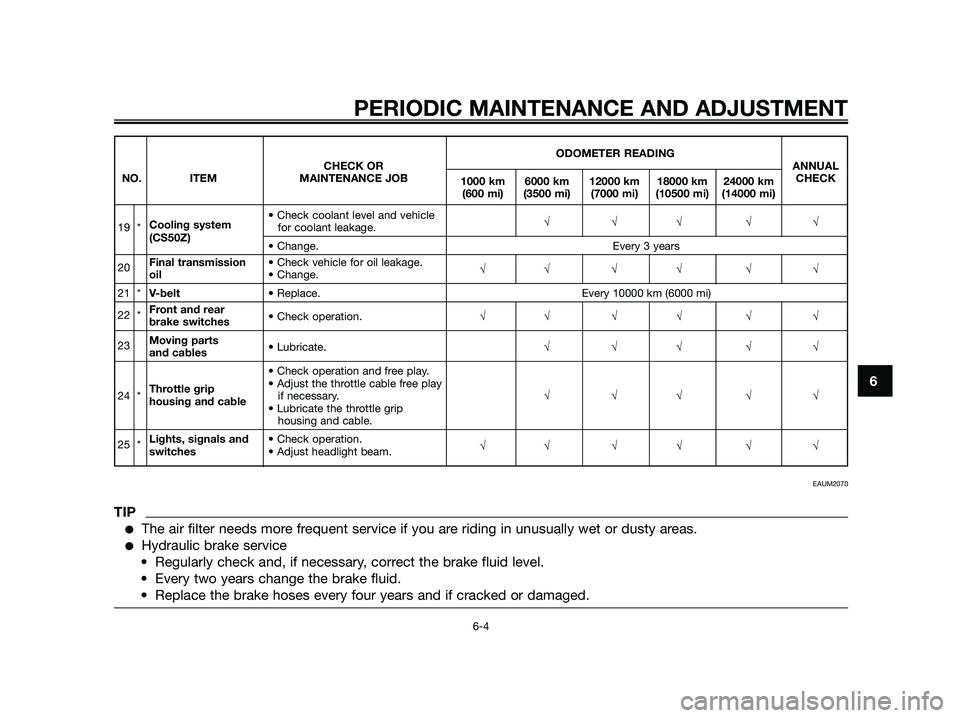
PERIODIC MAINTENANCE AND ADJUSTMENT
6-4
6
ODOMETER READING
CHECK OR ANNUAL
NO. ITEM MAINTENANCE JOB
1000 km 6000 km 12000 km 18000 km 24000 kmCHECK
(600 mi) (3500 mi) (7000 mi) (10500 mi) (14000 mi)
• Check coolant level and vehicle
19 *Cooling system
for coolant leakage.√√√ √√(CS50Z)
• Change. Every 3 years
20Final transmission • Check vehicle for oil leakage.
oil• Change.√√ √√ √ √
21 *V-belt• Replace. Every 10000 km (6000 mi)
22 *Front and rear
brake switches• Check operation.√√ √√ √ √
23Moving parts
and cables• Lubricate.√√√ √√
• Check operation and free play.
Throttle grip• Adjust the throttle cable free play
24 * if necessary.√√√ √√
housing and cable
• Lubricate the throttle grip
housing and cable.
25 *Lights, signals and • Check operation.
switches• Adjust headlight beam.√√ √√ √ √
EAUM2070
TIP
●The air filter needs more frequent service if you are riding in unusually wet or dusty areas.
●Hydraulic brake service
• Regularly check and, if necessary, correct the brake fluid level.
• Every two years change the brake fluid.
• Replace the brake hoses every four years and if cracked or damaged.
Page 44 of 76

TIP
If a torque wrench is not available
when installing a spark plug, a good
estimate of the correct torque is
1/4–1/2 turn past finger tight. Howe-
ver, the spark plug should be tighte-
ned to the specified torque as soon
as possible.
EAU20064
Final transmission oil
The final transmission case must be
checked for oil leakage before each
ride. If any leakage is found, have a
Yamaha dealer check and repair the
scooter. In addition, the final trans-
mission oil must be changed as
follows at the intervals specified in the
periodic maintenance and lubrication
chart.
1. Start the engine, warm up the
final transmission oil by riding the
scooter for several minutes, and
then stop the engine.
2. Place the scooter on the centers-
tand.
3. Place an oil pan under the final
transmission case to collect the
used oil.
4. Remove the final transmission oil
filler cap and final transmission
drain bolt to drain the oil from the
final transmission case.
1. Final transmission oil filler cap
5. Install the final transmission oil
drain bolt, and then tighten it to
the specified torque.
1. Final transmission oil drain bolt
1
1
11Tightening torque:
Spark plug:
20 Nm (2.0 m•kgf, 14.5 ft•lbf)
PERIODIC MAINTENANCE AND ADJUSTMENT
6-7
6
Page 45 of 76

6. Refill with the specified amount
of the recommended final trans-
mission oil, and then install and
tighten the oil filler cap. WAR-
NING! Make sure that no
foreign material enters the final
transmission case. Make sure
that no oil gets on the tire or
wheel.
[EWA11311]
7. Check the final transmission case
for oil leakage. If oil is leaking,
check for the cause.
EAUS1200
Coolant (CS50Z)
The coolant level should be checked
before each ride. In addition, the coo-
lant must be changed at the intervals
specified in the periodic maintenance
and lubrication chart.
EAUM2102
To check the coolant level
1. Place the vehicle on a level surfa-
ce and hold it in an upright posi-
tion.
TIP
●The coolant level must be chec-
ked on a cold engine since the
level varies with engine tempera-
ture.
●Make sure that the vehicle is
positioned straight up when
checking the coolant level. A
slight tilt to the side can result in
a false reading.
2. Check the coolant level through
the check window.
TIP
The coolant should be between the
minimum and maximum level marks.
1. Coolant level check window
2. Maximum level mark
3. Minimum level mark
3. If the coolant is at or below the
minimum level mark, remove the
cowling A. (See page 6-5).
4. Open the reservoir cap, and then
add coolant to the maximum
level mark. WARNING! Remove
only the coolant reservoir cap.
Never attempt to remove the
radiator cap when the engine is
hot.
[EWA15161]. NOTICE: If coolant
is not available, use distilled
MAX
MIN2
3
1
Recommended final transmission
oil:
See page 8-1
Oil quantity:
0.11 L (0.12 US qt, 0.10 Imp.qt)
Tightening torque:
Final transmission oil drain bolt:
18 Nm (1.8 m•kgf, 13.0 ft•lbf)
PERIODIC MAINTENANCE AND ADJUSTMENT
6-8
6
Page 52 of 76
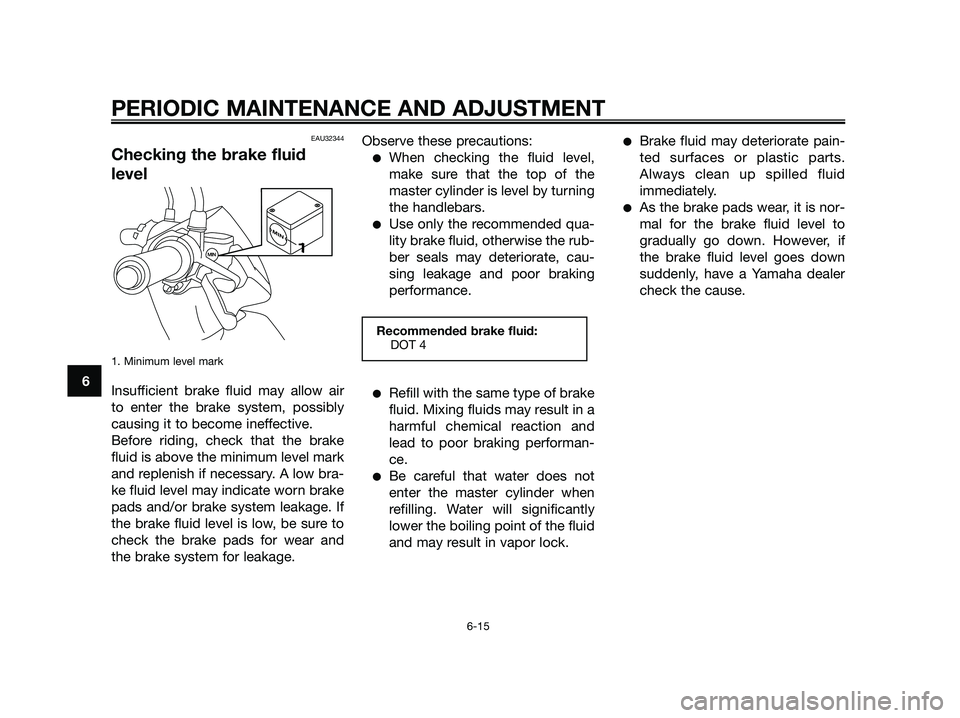
EAU32344
Checking the brake fluid
level
1. Minimum level mark
Insufficient brake fluid may allow air
to enter the brake system, possibly
causing it to become ineffective.
Before riding, check that the brake
fluid is above the minimum level mark
and replenish if necessary. A low bra-
ke fluid level may indicate worn brake
pads and/or brake system leakage. If
the brake fluid level is low, be sure to
check the brake pads for wear and
the brake system for leakage.Observe these precautions:
●When checking the fluid level,
make sure that the top of the
master cylinder is level by turning
the handlebars.
●Use only the recommended qua-
lity brake fluid, otherwise the rub-
ber seals may deteriorate, cau-
sing leakage and poor braking
performance.
●Refill with the same type of brake
fluid. Mixing fluids may result in a
harmful chemical reaction and
lead to poor braking performan-
ce.
●Be careful that water does not
enter the master cylinder when
refilling. Water will significantly
lower the boiling point of the fluid
and may result in vapor lock.
●Brake fluid may deteriorate pain-
ted surfaces or plastic parts.
Always clean up spilled fluid
immediately.
●As the brake pads wear, it is nor-
mal for the brake fluid level to
gradually go down. However, if
the brake fluid level goes down
suddenly, have a Yamaha dealer
check the cause.
Recommended brake fluid:
DOT 4
M
IN
1
PERIODIC MAINTENANCE AND ADJUSTMENT
6-15
6